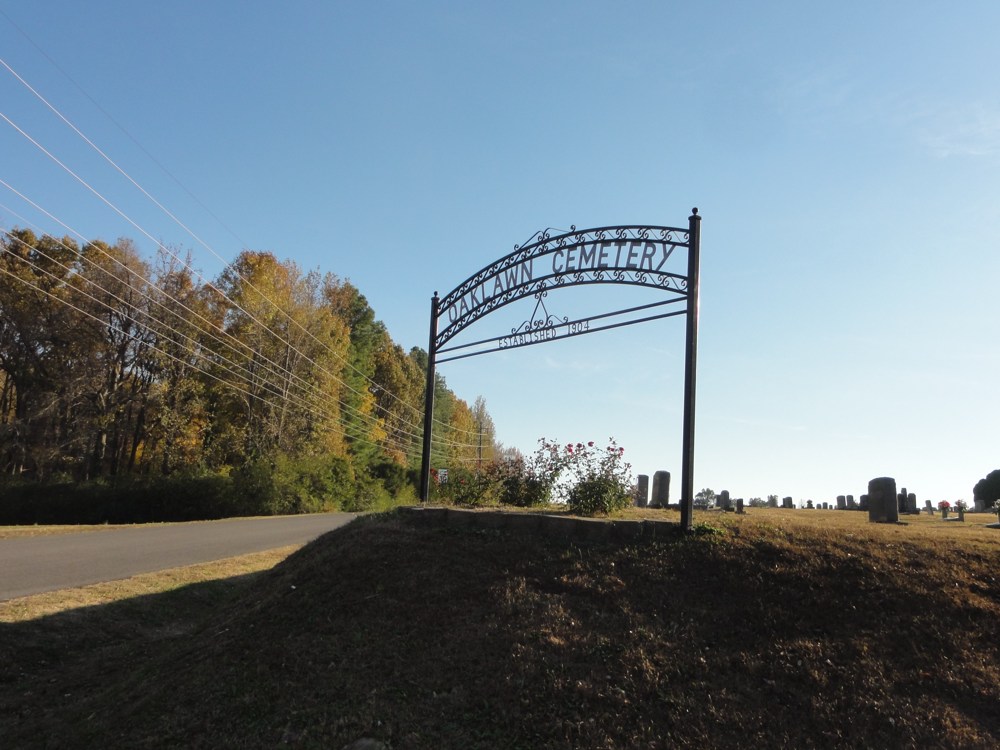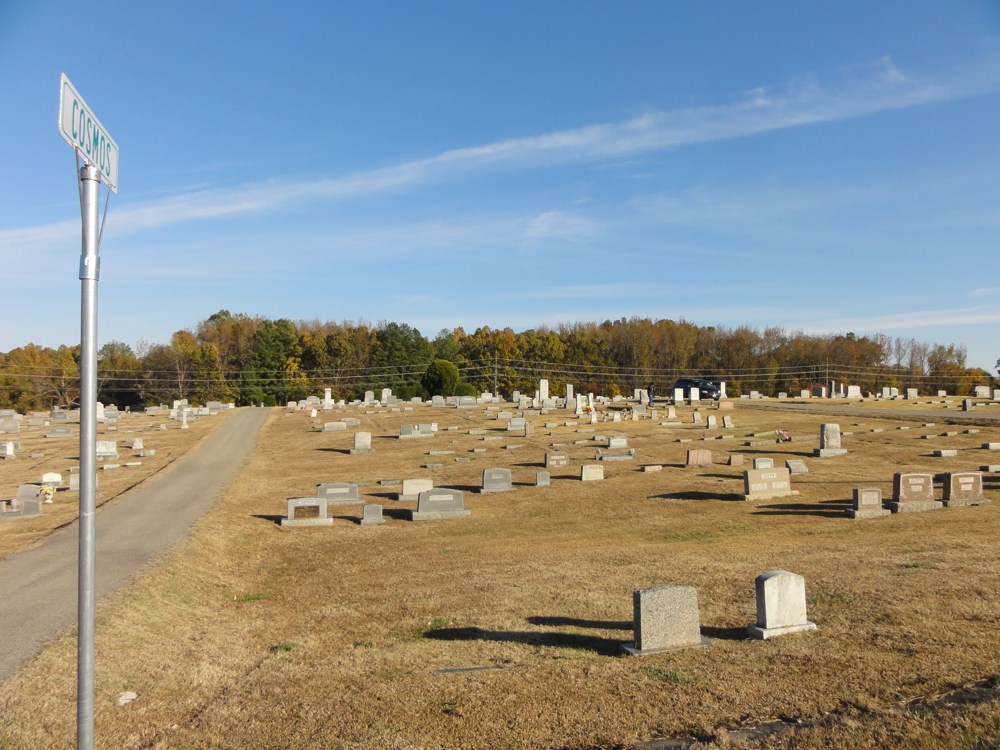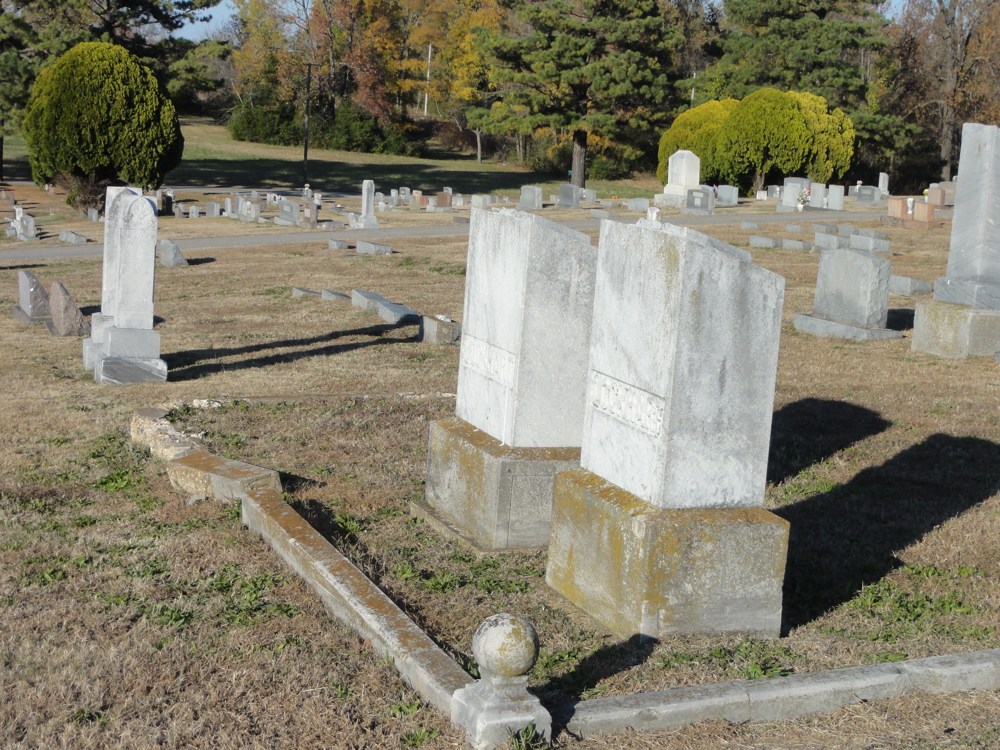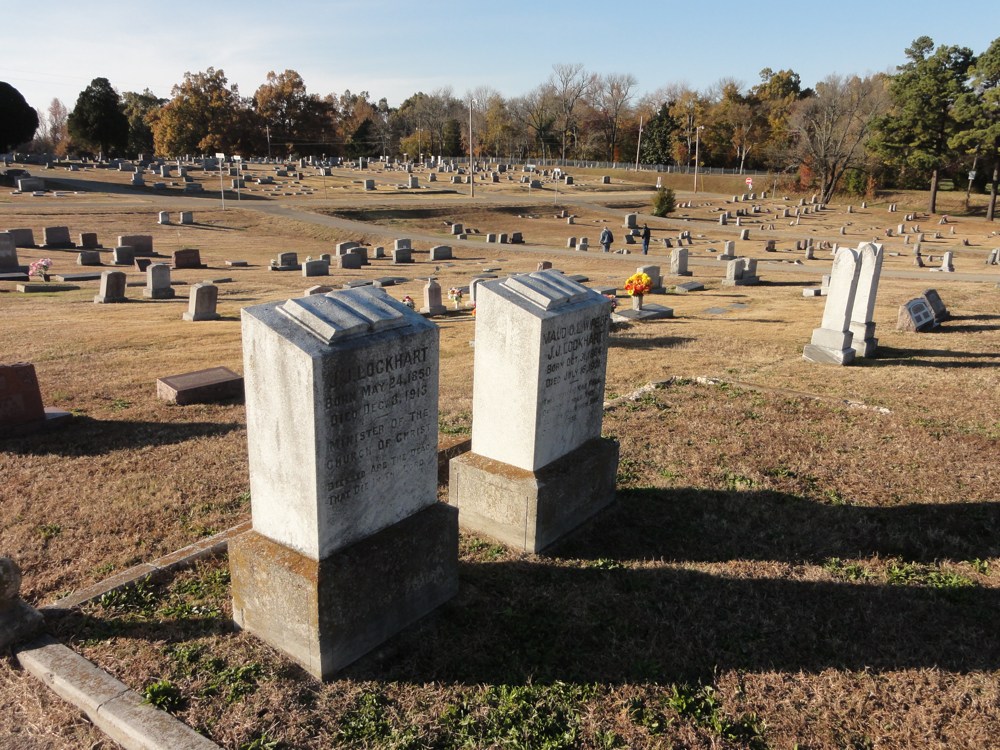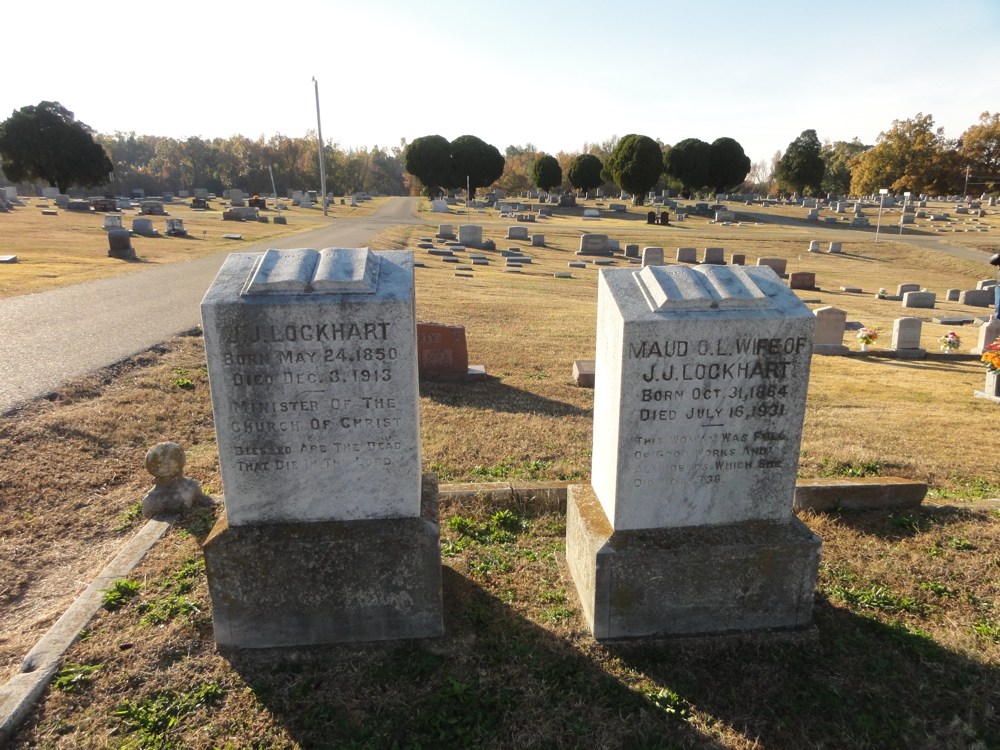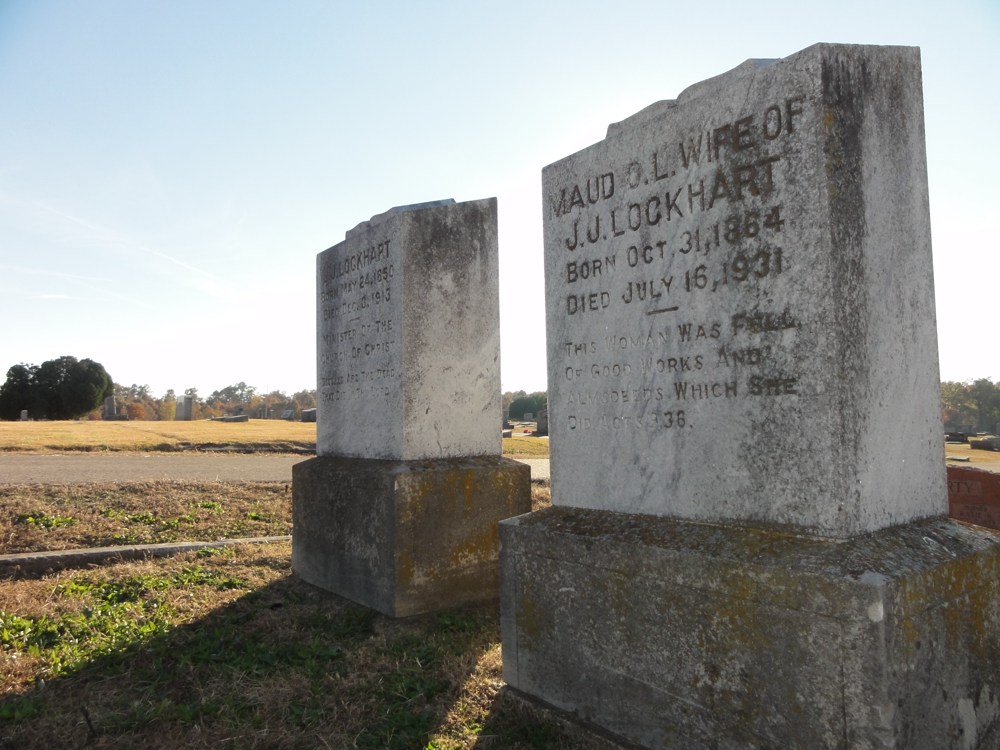John J. Lockhart
1850-1943
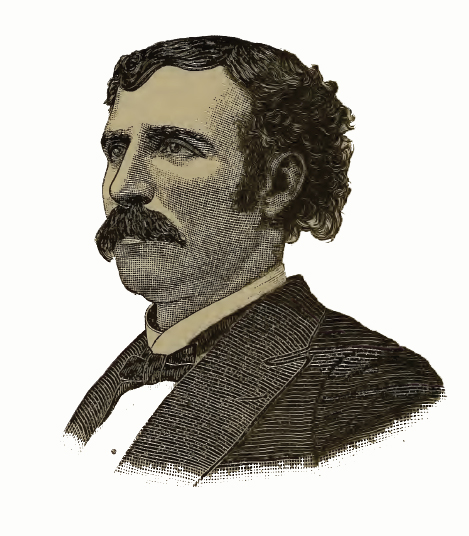
![]()
Biographical Sketch of John J. Lockhart
Born: Sheboygan County, Wisconsin, May 24, 1850.
Died: Marshall, Texas, December 3, 1913.
JOHN J. LOCKHART was born in Sheboygan county, Wisconsin, May 24th, 1850; but was reared and educated in Indiana, in which State he taught school for a number of years. He afterwards took special courses in Kentucky University and Bethany College, and finally graduated in the National School of Elocution and Oratory, at Philadelphia, Pa., in the year 1882.
Influenced by W. H. Krutzsinger, his father in the gospel, he entered the ministry in 1872. He served several churches in Indiana and Illinois, as a regular preacher, and held successful meetings with many more. He came to Texas in 1885, and located with the church at Ennis, where he labored two years during which time he held meetings at Palestine, Kaufman, Denton, Terrill, Waxahachie, Will's Point, Sulphur Springs, and other points, with marked success. At the beginning of the present year (1888) he accepted a call to Palestine, where he now resides. Bro. Lockhart is said to be like Apollos, "an eloquent man, and mighty in the Scriptures." He is uncompromising in his advocacy of primitive Christianity, and speaks the Word of the Lord with all boldness.
-Scott, Laurence W. (editor), Texas Pulpit by Christian Preachers. St. Louis: Christian Publishing Company, 1888. Pages 378-379.
![]()
Gospel Advocate Report
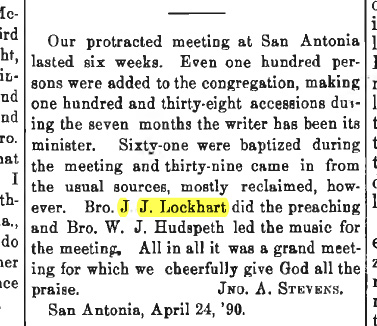
-Gospel Advocate, May 7, 1890, page 303.
![]()
SERMON VII.
THE TEMPLE
By J. J. Lockhart.
The study of the Temple and its service is one of the most interesting studies in the Word of God. Its typical relation to the diviner substance, Christianity, is clearly made known by the Holy Spirit. It was the most wonderful, as well as the most beautiful, structure of ancient or modern times, and was built according to the directions and model given by God himself to David, the second king of Israel, who enjoyed the reputation of being a man after God's own heart, in that he obeyed implicitly without asking a reason; collected much of the material; but on account of his being a warrior, having shed his fellowman's blood, was not permitted to build the Temple. God demanded one whose hands were not stained with blood to build his house. But unto David a son was promised, who should have that honor, and when he was born, God sent his prophet Nathan to name the child, and he called him Solomon, which means peace; and during the forty years of Solomon's reign not one war stains the Hebrew Chronicles.
Solomon ascended the throne of Israel at the age of 19 years. Upon his ascension God promised that he would give him whatever he desired, and he prayed for wisdom that he might govern the people, and God said, Because you have not asked long life, nor riches, nor the lives of thy enemies, but have asked for understanding to discern judgment; behold, I have done according to thy word, and lo, I have given thee a wise and an understanding heart, so that there was none like before thee, neither shall any rise like unto thee. He wrote parables upon everything from the hyssop by the wall to the tall cedar of Lebanon, and man, with all the advancements of civilization, has not gone beyond the wisdom of his proverbs. In the fourth year of his reign he began the building of that remarkable structure known as the temple, and completed it in the eleventh. During these seven years it did not rain in day time. The building with its courts occupied 31 acres of ground, and from the lower base to the pinnacle was 700 feet. It was built of white Parian marble and covered with a dome of silver, which reflected the rays of the morning sun presenting a picture of unsurpassing beauty and loveliness. In the construction of this building, Solomon employed 70,000 entered apprentices, 80,000 fellowcrafts, 30,000 Israelites who worked in the quarries, and over these were 3,300 masters, and over these were the three grand masters, Hiram king of Tyre, Hiram Abiff (or the widow's son) and Solomon. Many of the stones which composed the building were 70 feet long, 10 feet wide, and 8 feet thick. It has long been a problem how stones of such ponderous dimensions and weight were placed in position, as the ancients were entirely ignorant of our means for lifting heavy bodies; but a solution has been given by that celebrated missionary, Dr. Barclay, who visited Palestine some years since. While there, and on one of his evening strolls, his dog chased a hare into an aperture; following the instinct of his curiosity, the doctor examined the place. He found it to be an excavation. The Turks who have control of the city of Jerusalem and environments are extremely jealous and observe every move with great vigilance. He therefore abandoned the exploration till nightfall, having procured a ladder, flambaeu and other material necessary for the work, he proceeded to search what lay concealed in this opening. To his great surprise, he found it to be an old marble quarry. There were the lamp marks on the sides and an unfinished stone of huge dimensions lay before him. Taking the altitude of his position, he observed that it was the same as the height of the temple. He then conceived the reasonable hypothesis of placing these stones in position by means of an inclined plane, which was familiar to the ancients, and this perhaps is the reason these stones were sometimes called "rolling stones." Every stone was prepared before being placed in the building. The apostle Peter makes reference to these stones in his first epistle, 2d. chapter and 5th verse, where he says, "Ye also, as lively stones, are built up a spiritual house." Every one must be prepared before entering that spiritual temple, the heart must be purified, and faith is the means to that end. Acts 15:9. The life must be corrected and repentance does that work, now the man is ready for that step which places him into Christ, and baptism is that act (I. Cor.12:13); but some builders reverse the order, placing baptism first (infant baptism), and then preparing the heart and life afterwards. Let us take warning from the words of Paul, "According to the grace of God which is given unto me, as a wise master-builder, I have laid the foundation, and another buildeth thereon; but let every man take heed how he buildeth thereupon." (I. Cor. 3:10).
Around the temple stood a wall four feet high, called the "middle wall of partition." Three steps led over this wall, indicative of youth, of manhood and of age; and upon this wall was placed an inscription, written in Greek, Latin, and Hebrew, forbidding any Gentile to pass over, on penalty of death. Paul alludes to this wall, in his letter to the church at Ephesus (2:14,15): "For he is our peace, who hath made both one, and hath broken down the middle wall of partition between us, having abolished in his flesh the enmity, even the law of commandments contained in ordinances; for to make in himself one new man, so making peace." The day for special privileges has passed. "For there is now no difference between the Jew and the Gentile, for the same Lord over all is rich unto all that call upon him" (Rom. 10:12). The Master, in giving the commission, said, "Go, make disciples of all nations" (Matt. 28:19). At the house of Cornelius, Peter said, ''Of a truth I perceive that God is no respecter of persons, but in every nation he that feareth him and worketh righteousness is accepted with him." The temple opened eastward, receiving the first rays of light into its chambers. From the east comes our light, physical, political, mental, and religious. The birth place of Christianity was in the land of the Orient, and "westward the star of empire takes its course." The worshiper proceeding westward came to a gate called "Beautiful." It took twenty men to open and close it; passing through the gate, he proceeded through several courts until he came to one called ''The Court." Before him stood the great brazen altar. It was 20 cubits long, 20 cubits wide and 10 cubits high. On this, the sacrifice was placed and consumed.
The worshiper approaching, laid his hands on the sacrifice in token of his faith in the efficacy of the offering, and the blood of the victim was placed on the tip of his right ear, on the thumb of his right hand, and on the great toe of his right foot, indicating that his ears should ever be open to what God had to say to him; that his hands should ever be ready to do what was commanded, and that his feet should always be ready to go where G-od directed. In the person of our Savior we have both the altar and sacrifice. He sacrificed his humanity upon the altar of his Divinity; and we come to that altar, and lay hold of that sacrifice not with our hands, but with our hearts; grasping not with fingers, but with faith (Acts 8:37). The worshiper then proceeded to the great brazen laver, which stood directly between the altar and the door of the sanctuary; here he was required to bathe his whole body; he then put on clean white garments, indicative of purity. The bath in the laver was a type of Christian baptism. To this Paul alludes in his letter to Titus 3:5: "Not by works of righteousness which we have done, but according to his mercy he saved us, by the washing (or bath) of regeneration, and renewing of the Holy Spirit." Also, in Hebrews 10:22: "Let us draw near, with true heart, in full assurance of faith, having our hearts sprinkled from an evil conscience and our bodies washed with pure water." One thought to our religious neighbors:If pardon is obtained before baptism, then the clean white garments, indicative of the forgiveness of sins, should have been received at the altar; but observe, they were not received till after he had bathed in the laver.
The worshiper then proceeded, and the beautiful folding doors opened at his approach, and he entered the sanctuary, which was a type of the Church of Christ (Heb. 9:1,10). Beneath was the Mosaic pavement, denoting the checkered scenes of life; above was a canopy, studded with seven stars, indicating that God's eyes are always on his people; around the ceiling ran a border of fruits and flowers, signifying that God withholds no good thing from his people. The room was fifty cubits long, twenty cubits wide and twenty cubits high. It had three pieces of furniture. The number three seems to be a sacred number. Three persons in the Godhead—the Father, the Son, and the Holy Spirit; three dispensations in the unfolding of the scheme of redemption—the patriarchal, Jewish, and the Christian; three lights in the universe—starlight, moonlight, and sunlight; three eras in man's life—youth, manhood, and age; three states in man's existence—the present life, the intermediate between death and the resurrection, and the state after the resurrection; three things took man from Eden—hearing a lie, believing a lie, and obeying a lie; three things restore him to the favor of God—hearing the truth, believing the truth, and obeying the truth; three steps to make a man a Christian—faith, repentance, and baptism.
On the south side of the sanctuary stood the golden candlestick, with seven branches. The number 7 also seems to have a definite significance. There are seven stars in the Pleiades; seven wise men of Greece; seven wonders of the world; seven days in a week; seven churches in Asia; seven spirits of God; seven steps to take, after coming into Christ: add to your faith, virtue, knowledge, temperance, patience, godliness, brotherly kindness and love; and there are just seven divisions of the word of God, which the seven branches of the candlestick typified; the law, the prophets, and the psalms; the histories of Christ, or the testimony of the evangelists; Acts of the Apostles, epistolary writings, and the Apocalypse. There are 66 books in the Bible; 39 in the Old Testament, and 27 in the New. Of the 39 books, 17 are historical, 17 prophetic, and five devotional.
Of the New Testament, four are biographical, one historical, 21 didactic, and one prophetic. Of the biographies, Matthew wrote his to the Hebrews, and he held the Messiahship prominently before them. They desired a deliverer, a Savior who could free them from bondage, and Jesus was that Savior. Mark wrote to the Romans. Their idea was royalty, kingly power; hence Jesus is held out to them as a king, and his coronation assured in the last verse of Mark's testimony. Luke wrote to the Grecians. Their ideal was perfect manhood, hence, Christ’s humanity in its perfection is brought before them. John wrote his testimony to the Asiatics, and their ideal was devotion, adoration; hence, he placed before them the Divine nature of our blessed Savior. In these four testimonies we have the perfection of the Master exhibited, his messiahship, his kingly power, his perfect humanity, and divinity. The book known as Acts of Apostles is catholic. Of the epistolary writings, nine were written to the Gentile churches; six to the Hebrews, and six to individuals. The Book of Revelation is also universal. In this grand old book, the Bible, we have the light to guide us, all things necessary to life and godliness. And, as the sanctuary had no light save that which was emitted from the candlestick, so should the true sanctuary, the church of Christ, have no other than that which eminates from the word of God. But let us have all the nobs burning, not take one part of the Bible to the exclusion of the others.
On the north side of the sanctuary stood the table of shewbread. It was made of acacia wood, overlaid with pure gold, two cubits was the length of it, one cubit the width, and one and a half cubits the height. Around it was a crown of gold. On this table was placed twelve loaves, one for each of the tribes of Israel, signifying that God was present with his people, hence, called "Presence bread." The number twelve seems also to have been sacredly applied. We read of the twelve sons of Jacob, the twelve tribes of Israel, twelve signs of the Zodiac, twelve months of the year, twelve apostles of Christ, twelve thrones, twelve foundations of the New Jerusalem, and twelve gates of pearl of that glorious city. But we have only one loaf, as we have but one body the church. Christ is not divided. He said, "Go make disciples of all nations, baptizing them into the name of the Father, and of the Son, and of the Holy Spirit." At one time, God permitted the Romans to have their religion; the Grecians, theirs; the Persians, theirs; the Egyptians, theirs, and gave the Hebrews, theirs; but he no longer winks at this ignorance, but now commands all men everywhere to repent (Acts 17:30). His people should be one.
At the west end of the sanctuary, and near the veil, stood the golden altar. It was two cubits high, a cubit long, and a cubit wide. It was made of acacia wood, overlaid with pure gold, had horns at each of its four corners, and a crown of gold encircled it. On this the morning and evening incense was burned, which typified the prayers of the saints (Rev. 5:8). But some would take this altar from its position in the sanctuary, and place it out in the court, near the great brazen altar. God placed it in the sanctuary, and near the veil. Perhaps the last thing we will do in this life will be to commend our souls to our Savior.
"Prayer is the Christian's vital breath,
The Christian's native air.
His watch-word at the gate of death;
He enters heaven by prayer."
The worshiper passes through the veil, which represents death, and he stands in the Holy of Holies. This apartment is a perfect cube, 20 cubits an every side. No Mosaic pavement is now beneath, nor stars above; but the room is covered with solid gold, cherubic figures are flying in every direction. Two cherubim stood in the center of the room—one whose wing touches the north' side, and the other whose wing is against the south, their two inner wings meeting in the center of the room. Beneath these wings was placed the Ark of the Covenant. It was a small chest, or box, two cubits long, and one and a half cubits wide, and one and a half cubits deep. Over this was placed a lid encircled with a crown of gold, and the Ark was covered with pure gold, within and without. The tables of stone upon which God wrote the Ten Commandments were placed in the ark; on either end of the ark stood cherubims, with their faces turned inward and downwards, their wings meeting above. Between the angels was the shechinah, or the visible presence of God, a light that God bestowed on the ark at its dedication. We find no candlestick here, no window, no light save the presence of God. This was a type of heaven; and it shows us the purity of that abode, the angelic hosts which surround the throne of God, and the ineffable glory of Jehovah's presence. No sun, no moon, no stars, but the throne of God and the Lamb is the sun which shines with the splendor of the everlasting day. This is the home of the pure. This is the mansion prepared for those who serve the Christ of God.
Gentle reader, you have followed us to the Holy of Holies. Let us now retrace our steps. No one was permitted to enter the Holy of Holies who had not passed through the sanctuary. And this answers the oft asked question, can't a man go to heaven without being a member of the church? No one was permitted to enter the sanctuary who had not on the clean white garments; no one possessed those garments who had not bathed in the laver; no one was permitted to bathe in the laver who had not been to the altar. In this God has given us a picture of the scheme of redemption, and it is so plain that the way-faring man need not err therein.
Let us take one more view of this wonderful structure before leaving it. The first thing we came to was a wall. This is infidelity; that passed, we came to a gate. That is our skepticism, that conquered, we go to the altar, then the laver. Then we come to the doors, which open at our approach; then we come to the veil, only a thin partition between us and heaven.
-Scott, Laurence W. (editor), Texas Pulpit by Christian Preachers. St. Louis: Christian Publishing Company, 1888. Pages 89-100.
![]()
Directions To The Grave of J.J. Lockhart
The Lockhart family plot is located in the Oaklawn Cemetery in Jonesboro, Arkansas. The cemetery lies to the west of Jonesboro off of Hwy. 18. Take exit 47, and turn right on W. Washington Ave. Immediately turn right on W. Matthews Ave. Enter the second entrance of the cemetery. Take the third left and you will be moving up a little hill. When you get near the top you will see a little enclosure on the left. This is the LOCKHART plot.
GPS Location
35°50'05.3"N 90°44'14.1"W
or D.d. 35.834802,-90.737251
![]()

Maud O.L. Wife Of
J.J. Lockhart
Born October 31, 1864
Died July 16, 1931
This Woman Was Full
Of Good Works And
Alms Deeds Which She
Did - Acts 9:36
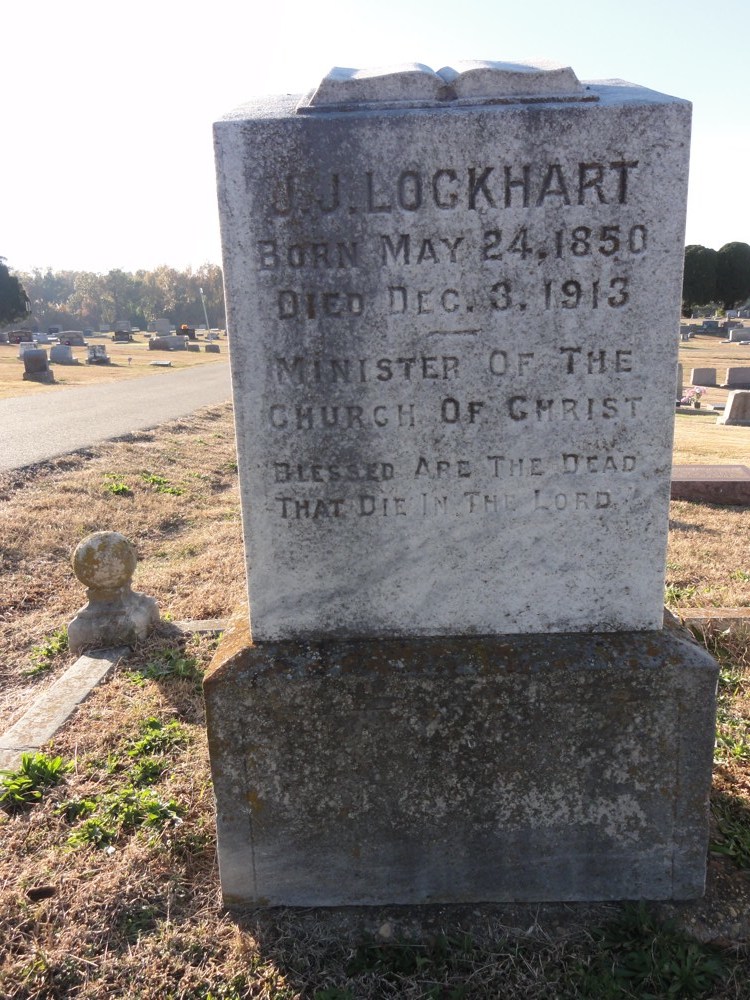
J.J. Lockhart
Born May 24, 1850
Died December 3, 1913
Minister Of The
Church Of Christ
Blessed Are The Dead
That Die In The Lord
![]()
Photos Taken 11.13.2014
Webpage produced 11.29.2014
Courtesy of Scott Harp
www.TheRestorationMovement.com
*Special thanks to Tom L. Childers and Charlie Wayne Kilpatrick for assisting in the burial location. They along with your web editor took a trip into northern Arkansas to find the graves of gospel preachers of yesteryear in November, 2014. We traveled together three days and located the final resting places of nearly forty preachers and their families. It was a great trip. Many of the personalities we researched were chronicled in Boyd E. Morgan's book, Arkansas Angels, or later in Dr. Michael L. Wilson's book, Arkansas Christians: A History of the Restoration Movement in Randolph County, 1800-1995.
![]()
